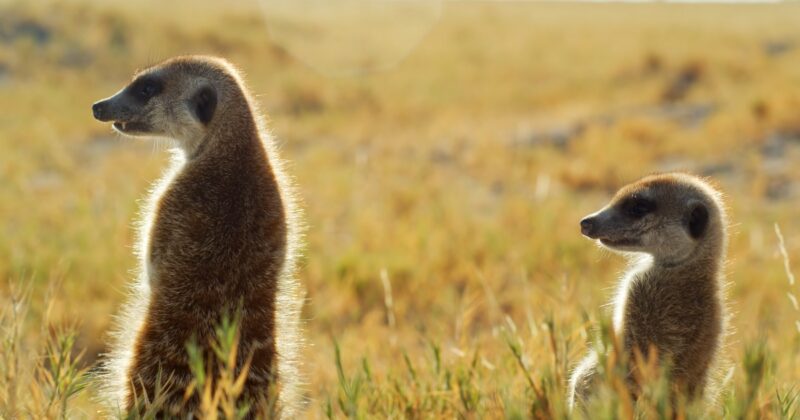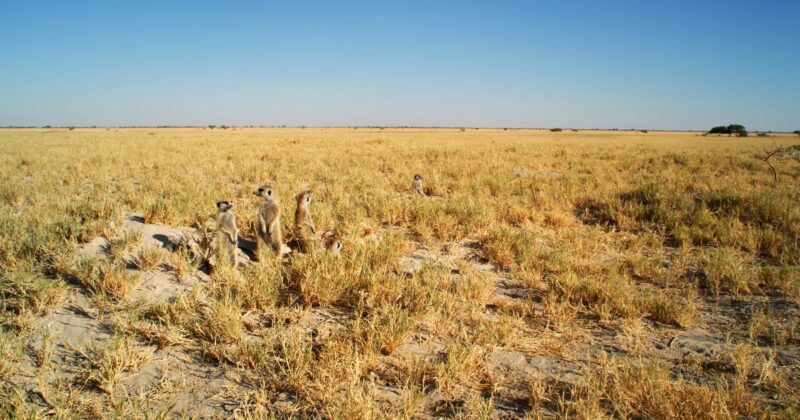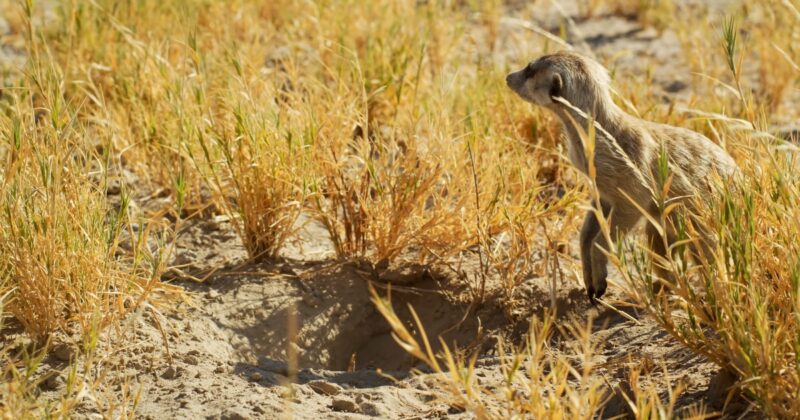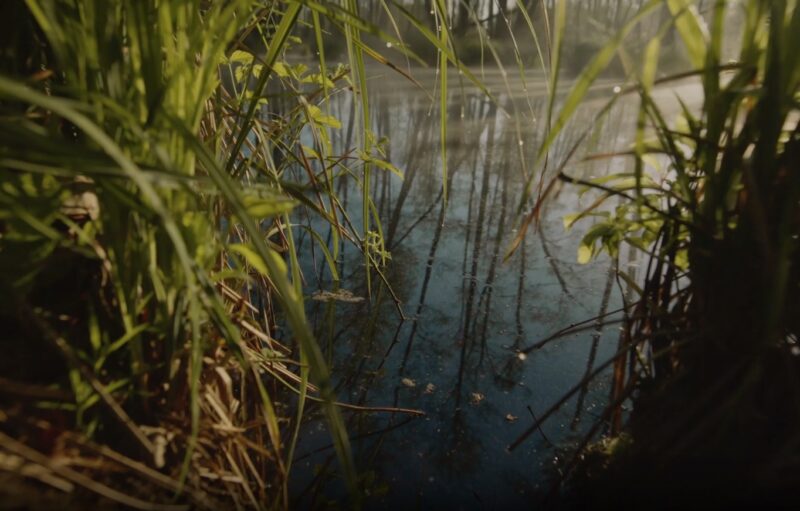Meerkats are well-known as animals that stand on their back legs and look around inquisitively. They are small mongoose found in southern Africa and Western North America. It is characterized by a broad head, large eyes, a pointed snout, long legs, a thin tapering tail, and a brindled coat pattern.
The head-and-body length is around 24–35 cm (9.4–13.8 in), and the weight is typically between 0.62 and 0.97 kg (1.4 and 2.1 lb). The coat is light grey to yellowish-brown with alternate, poorly defined light and dark bands on the back.
Meerkats have foreclaws adapted for digging and can thermoregulate to survive in their harsh, dry habitat. Three subspecies are recognized. Have you ever watched a group of meerkats and noticed how often they stand up on their hind legs? This behavior, while adorable, is not just for show.
“Meerkats might just be the best example of teamwork in the animal kingdom. Every action from standing guard to babysitting the young is a group effort.” – David Attenborough
Key Takeaway
- Meerkats stand to scan potential predators and keep their group safe
- This stance helps them stay cool by minimizing contact with hot ground.
- Standing reinforces social bonds as they share sentinel duties, showcasing their cooperative spirit.
Why do They Stand Up on Their Back Legs?

This small mongoose lives in groups of as little as three members to larger ones ranging up to 30 members. These small animals are among the few that can live in such large groups successfully. A meerkat family group is referred to as a mob, a gang, or a clan.
Many people are familiar with the upright position of a meerkat. You will either see one meerkat or a group standing together. Animals, whether big or small, have distinct behavior, and there is a reason for this. It helps scare off predators. It’s a sophisticated survival strategy that showcases the adaptability and intelligence of these small, social creatures.
Meerkats are immune to venom to such a limit that even if bitten by cobra, they will feel unwell for some time and will go back to normal.
Sentry Position
They have four legs and spend most of their time on all four legs, such as a dog would. However, once in a while, you will see this mongoose standing on its back legs. This is generally referred to as the sentry or watch guard position.
Every day in the morning, the clan heads out for food. Duties are distributed among the family members, with often one or more babysitters being left behind to take care of the young pups. One of the meerkats takes up the sentry role while the rest begin their food search. It is usually one family member who is chosen to keep watch.
However, sometimes, it can be two of them or more. The meerkat on sentry duty will find a high spot, such as a termite mound or even a hill, and stand on its hind legs to watch the rest of the gang. The one who is on guard duty will stand on its hind legs.
They will be better positioned to scan the surroundings for predators by being in this position. The predators of a meerkat group can be both aerial and terrestrial. Due to being so small, the meerkat has to search for food quickly and that’s how they spend much less time in the open and away from predators.
This animal will try to get back to their burrows very quickly. The shelters protect them from their natural predators. The aerial predators of a meerkat are large birds such as eagles and hawks.
This animal also needs to look out for predators on the ground—many terrestrial predators, such as jackals, include animals that are much more significant than them. They know that having one or more of them standing guard means that they can concentrate on foraging for food.
If the meerkat guarding the gang senses impending danger or a predator in the vicinity, he will warn the other members of the mob. The one who is on sentry duty will let out a sound to warn the other members. This sound is generally a loud bark or high-pitched whistle.
Upon receiving the meerkat’s warning sound on guard duty, the other gang members will spontaneously run for cover. When there are no predators around, this mongoose will let the rest of the foraging meerkats know. The one who is on watch duty makes a peeping sound when everything is going well.
Meerkat’s have a great vision. Eyes is their most developed sense.
| Characteristic | The way of living |
|---|---|
| Scientific Name | Suricata Suricatta, also known as suricate. |
| Location | Small mongoose species found in South Africa. |
| External Features | Broadhead, large eyes, a pointed snout, long legs, a thin tapering tail, and a striped coat pattern. |
| Size and Weight | Weight: 0.62 to 0.97 kg. Length: 24 to 35 cm on average. |
| Fur/Coat | Yellowish to brown color with dark and light bands. |
| Fore Claws | Strong and able, mostly useful for digging soil. |
| Thermoregulation | Ability to maintain body temperature irrespective of environmental conditions, enabling survival in harsh and dry areas. |
| Habitat | Prefer stony, calcareous areas and live in large burrow systems in plains. |
| Social Structure | Meerkats live in groups called mobs or gangs, consisting of up to 30 members. These highly social animals rely on a complex hierarchy and division of labor for survival. |
| Communication | They use a variety of vocalizations to communicate with one another, including warning calls for different types of predators. |
| Diet | Primarily insectivores, meerkats also eat small rodents, birds, eggs, and fruit. |
| Attack Methods | They hunt in groups, using their sharp claws and teeth to capture and kill prey. They often work together to tackle larger prey. |
| Defense Mechanisms |
|
Warmth
There is another reason why they stand up straight on their back legs. This reason is to warm up their bodies from the cold nights. The sun’s warmth reaches a more significant part of their bodies when standing up.
The skin area under a meerkat’s belly does not have much fur or hair and can get cold. This area under their belly is a black patch of skin. In the morning, these mongooses stand up on their hind legs to expose this skin area to the sun’s warmth. This is their typical way of warming up after a long, cold night in their burrows.
Meerkats are known to be the most murderous mammal, who can be killed by their own species.
Defending Their Territories
Similar to many wild animals, these small mongooses are fiercely territorial. They do not like other meerkats from other groups invading their territory. They will fight off and sometimes kill rival meerkat clans.
They will threaten invaders by standing up straight on their hind legs. Standing up on their back legs is used to portray dominance.
Did you know that they can be aggressive and deliver a nasty bite to humans? Especially aggressive to people they don’t know. Of course, these aren’t ideal traits for a household pet. They dig: as meerkats naturally spend hours every day in the wild digging for food or making new burrows, this can become problematic in the home.
How Can They Balance While Standing?

Not many wild animals can stand up on their hind legs the same way that they can. A meerkat is unique in that it can stand on its hind legs continuously for over an hour. This small mongoose has a long slender tail that balances its two hind legs while standing up.
The bottom propels the animal up so it does not fall backward. The long tail also enables the meerkat to appear taller while in a standing position. This is important in aiding its vision of the surrounding area.
Despite living in the desert unbelievably meerkats do not need extra water in their diets. They get all the moisture they need from the insects and grubs they eat. A human would die within 3 – 5 days without additional water.
Around humans
Many wild animals, tiny in size, tend to be naturally cautious of humans. However, they have proven to be very friendly to humans. Meerkats are not shy of standing up when there are humans around.
Although this behavior can take some time, they get habituated to humans’ presence. They also are not afraid of humans as long as they feel safe and sense no danger to themselves. It is easy to gain these small mammals’ trust to the point where they get comfortable around you. Meerkats can be pretty playful around humans.
Animal photographers who spend time in the wild find it easy to get close to meerkats. This animal may sometimes climb on top of a person and use him as higher ground. Meerkats will then stand on their hind legs to begin scanning their surroundings.
Other Activities While Standing

They stand on their hind legs to better view the surroundings. However, these little creatures are vigilant. Sometimes, females will breastfeed the young pups while standing up. They are pretty skilled and do it effortlessly. This animal will also engage in playful acts while standing on their hind legs.
The North American kind live in Western North America. Many of them live in wild areas such as deserts, scrublands, savannahs, grasslands, forests, and swamps of North America. But few are often seen in urban areas.
These kinds of meerkats tend to be omnivores. They obtain some of their food from garbage bins. On the other hand, wild meerkats can also visit civilized areas when looking for food. You might even have spotted one close to a sidewalk. This animal can be found in all North American regions except the Arctic.
Related Posts:
- What Do Black Bears Eat? Insights into Their Diet
- Banded Water Snake: Facts, Diet, Habitat - Secrets…
- How Will Climate Change Affect Arctic Animals? -…
- How Do Red Foxes Survive Winter? Survival Guide
- How Good Is a Black Bear’s Sense of Smell? Into the…
- What Biome Do Grizzly Bears Live In? Into the Great…








